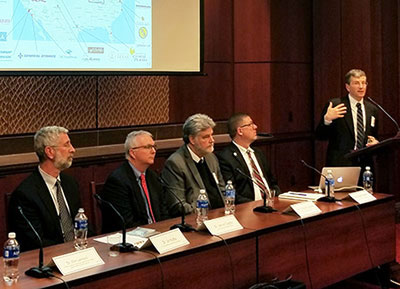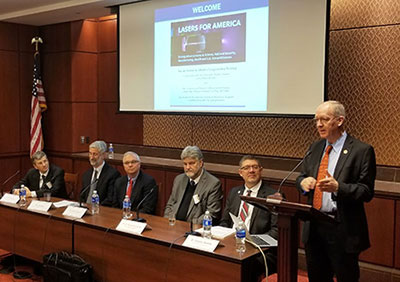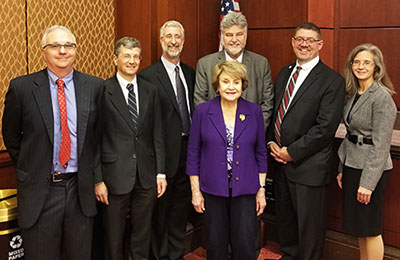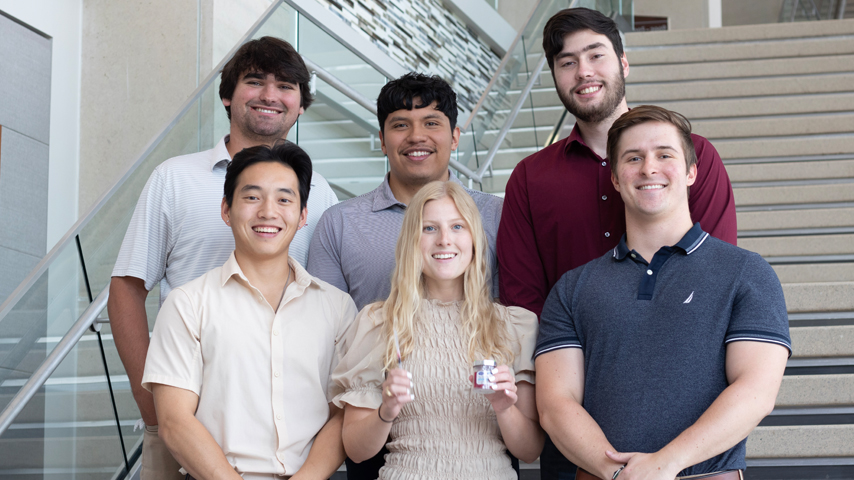ASME Briefing on Capitol Hill Highlights Cutting-Edge Lasers
ASME Briefing on Capitol Hill Highlights Cutting-Edge Lasers
Jan. 12, 2018

ASME recently convened a congressional staff briefing titled, “Lasers for America: Driving Advancements in Science, National Security, Manufacturing, Health, and U.S. Competitiveness.” The briefing, which was held Dec. 12, followed the release of a National Academies of Sciences (NAS) study, titled “Opportunities in Intense Ultrafast Lasers: Reaching for the Brightest Light.”
The NAS study, which was conducted at the request of the Department of Energy, the Office of Naval Research and the Air Force Office of Scientific Research, evaluates the current state of high-intensity, ultrafast lasers and laser technologies, and assesses the value of future high-intensity laser science programs and facilities in the United States and around the world.
U.S. investments in science and technology led to the development of the laser in 1960. Since then, the laser has become a ubiquitous tool across a broad range of applications. The laser is now used to perform cutting edge experiments at advanced particle accelerators, to aid in the development of advanced materials for national security applications, and to enable novel treatments to treat cancer and other medical conditions. Today, the worldwide laser market is valued at roughly $10.5 billion and growing annually.

Another major breakthrough in laser technologies, again led by researchers in the United States, is the short-pulse, high-peak power laser. This new class of laser could have transformative applications with far reaching impact, including the development of small, compact particle accelerators that are a fraction of the length of contemporary accelerator systems, or powerful new specialized medical treatment and scanning capabilities.
Despite the United States’ early lead in this technology, the country is at risk of losing its competitive advantage. According to the NAS study, countries in Europe and Asia are investing heavily in this foundational technology and plan to overtake the U.S. At the same time, U.S. federal investment in the research and development of high-peak power lasers has been declining significantly, leaving American researchers and companies vulnerable to international competition.
ASME partnered with internationally recognized scientists and representatives from American industry for the Dec. 12 briefing to provide insights to policymakers on the current state of laser science and technology development. Panelists discussed the key role that lasers play in U.S. innovation and economic competitiveness, and how the nation can maintain preeminence in laser technology.

The briefing opened with comments from Congresswoman Louise Slaughter (D-NY), who spoke about the economic impact that laser science has had on the Rochester, New York region, and Congressman Bill Foster (D-IL), who is currently the only physicist in Congress and a passionate champion for physical sciences funding in Congress. Connie Lausten, chair of the ASME Energy Public Policy Task Force, and moderator Dr. Gregory Quarles, chief scientist at the Optical Society, guided discussion among the panelists, who offered laser technology expertise from across industry and academia. Taking part in the panel were E. Michael Campbell, director of the Laboratory for Laser Energetics at the University of Rochester; James Clayton, senior scientist at Varian Medical Systems; Jim Kafka, chief technology officer for Spectra-Physics, a division of MKS; and Wim Leemans, director of the Accelerator Technology and Applied Physics Division at Lawrence Berkeley National Laboratory.
To read more about ASME’s Congressional Briefings, please visit: https://www.asme.org/about-asme/get-involved/advocacy-government-relations and to download the report, please visit: https://www.nap.edu/catalog/24939/opportunities-in-intense-ultrafast-lasers-reaching-for-the-brightest-light. If you have questions about the Dec. 12 briefing, please contact Paul Fakes, fakesp@asme.org.
Paul Fakes, ASME Government Relations




